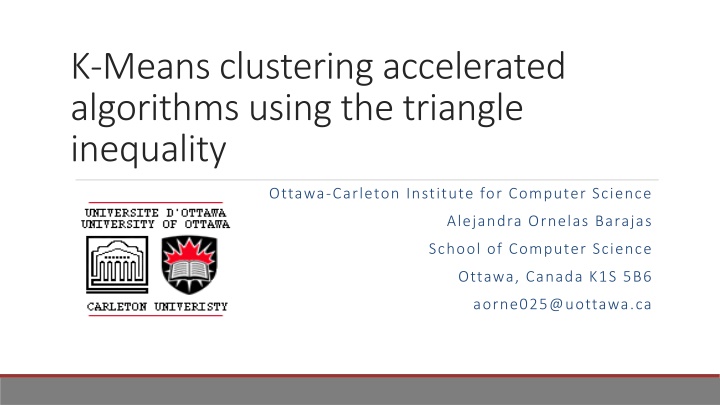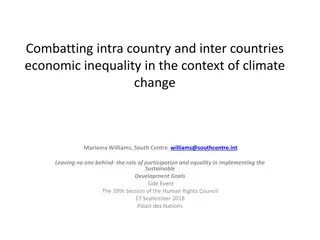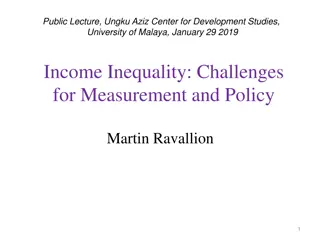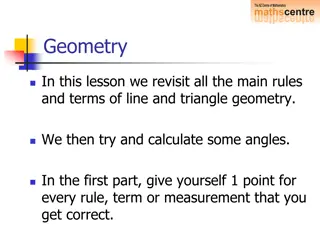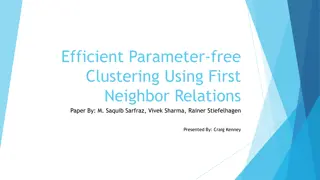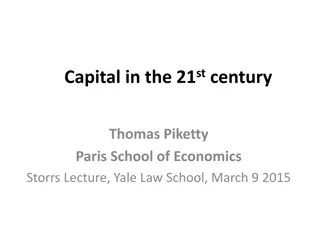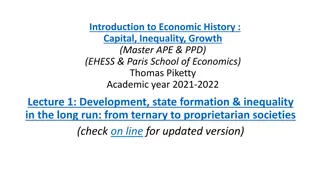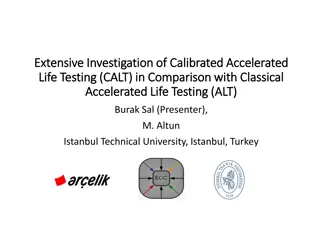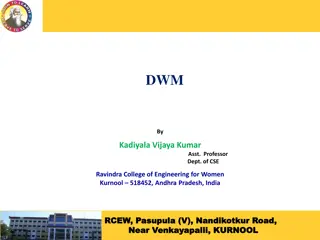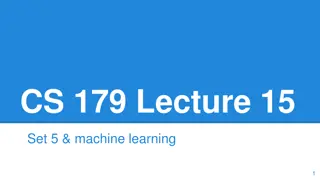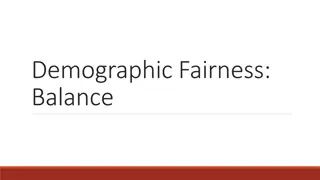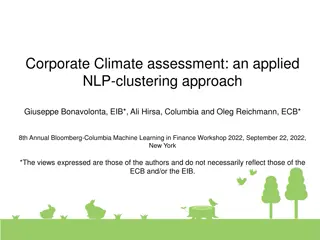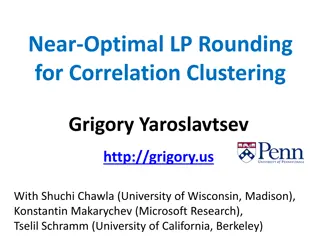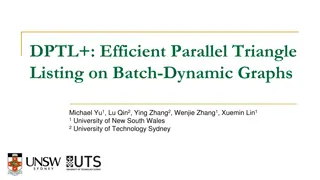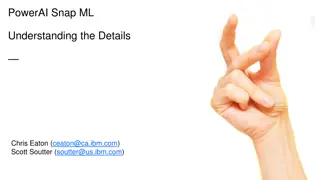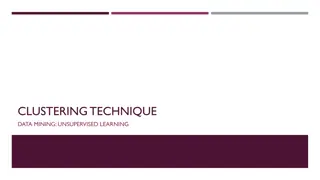Accelerated Algorithms for K-Means Clustering Using Triangle Inequality
Popular in data analysis, the k-means algorithm aims to minimize distances between data points and cluster centers. Discover how the triangle inequality can optimize this process with accelerated algorithms like Elkan's, Hamerly's, and Drake's.
Download Presentation

Please find below an Image/Link to download the presentation.
The content on the website is provided AS IS for your information and personal use only. It may not be sold, licensed, or shared on other websites without obtaining consent from the author.If you encounter any issues during the download, it is possible that the publisher has removed the file from their server.
You are allowed to download the files provided on this website for personal or commercial use, subject to the condition that they are used lawfully. All files are the property of their respective owners.
The content on the website is provided AS IS for your information and personal use only. It may not be sold, licensed, or shared on other websites without obtaining consent from the author.
E N D
Presentation Transcript
K-Means clustering accelerated algorithms using the triangle inequality Ottawa-Carleton Institute for Computer Science Alejandra Ornelas Barajas School of Computer Science Ottawa, Canada K1S 5B6 aorne025@uottawa.ca
Overview Introduction The Triangle Inequality in k-means Maintaining Distance Bounds with the Triangle Inequality Accelerated Algorithms Elkan s Algorithm Hamerly s Algorithm Drake s Algorithm Conclusions References
1. Introduction The k-means clustering algorithm is a very popular tool for data analysis. The idea of the k-means optimization problem is: Separate n data points into k clusters while minimizing the distance (square distance) between each data point and the center of the cluster it belongs to. Lloyd s algorithm is the standard approach for this problem. The total running time of Lloyd s algorithm is O(wnkd) for w iterations, k centers, and n points in d dimensions.
1. Introduction Observation: Lloyd s algorithm spends a lot of processing time computing the distances between each of the k cluster centers and the n data points. Since points usually stay in the same clusters after a few iterations, much of this work is unnecessary, making the naive implementation very inefficient. How can we make it more efficient? Using the triangle inequality
2. The Triangle Inequality in k-means Claim: If center c is close to point x, and some other center c is far away from another center c , then c must be closer than c to x. c x Proof: Consider the already computed distances: ? ? ??? ? ? By the triangle inequality we know that: ? ? ? ? + ? ? c
2. The Triangle Inequality in k-means And we also know that: 2 ? ? ? ? c So: x 2 ? ? ? ? ? ? ? ? ? ? Which proves that c is not closer than c to x without measuring the distance ? ? Corollary: Some point-center distances of the k- means algorithm do not need to be computed. c
3. Maintaining Distance Bounds with the Triangle Inequality Assuming that the distance ? ? has been calculated. After c moves to c we measure ? ? . The upper and lower bounds on ? ? are given by ? ? ? ? ? ? ? ? + ? ? Thus, c must be inside the region bounded by these two circles.
4. Accelerated algorithms: How do we a accelerate Lloyd s algorithm? Using upper and lower bounds.
4.1. Elkans Algorithm 1 upper bound: ?(?) ? ? ?(? ? ) k lower bounds: ?(?,?) ? ? ?(?) Main problem? Requires a lot of memory to store each k lower bounds.
4.2. Hamerlys Algorithm Hamerly modified Elkan s algorithm by using only one lower bound per point, ? ? .This lower bound represents the minimum distance that any center (that is not the closest center) can be to that point. How is this better? Consider the two following cases: If ?(?) ?(?): It is not possible for any center to be closer than the assigned center. Thus, the algorithm can skip the computation of the distances between ?(?) and the k centers. If ?(?) < ?(?): It might be that the closest center for ?(?) has change. The algorithm first tightens the upper bound by computing the exact distance ?(?) ?(?(?)) . Then it checks again if ?(?) ?(?) to skip the distance calculations between ?(?) and the k centers. If not, then it must compute those distances.
4.3.Drakes Algorithm Drake and Hamerly combine the first two algorithms using 1 < ? < ? lower bounds on the b closest centers to each point. The first b 1 lower bounds for a point represent the lower bounds to the associated points that are ranked 2 through b in increasing distance from the point. The last lower bound (number b, furthest from the center) represents the lower bound on all the furthest k b centers. Experimentally, Drake determined that for k>8, k/8 is a good floor for b.
5. Conclusions Elkan s algorithm computes fewer distances than Hamerly s, since it has more bounds to prune the required distance calculations, but it requires more memory to store the bounds. Hamerly s algorithm uses less memory, it spends less time checking bounds and updating bounds. Having the single lower bound allows it to avoid entering the innermost loop more often than Elkan s algorithm. Also, it works better in low dimension because in high dimension all centers tend to move a lot. For Drake s algorithm, increasing b incurs more computation overhead to update the bound values and sort each point s closest centers by their bound, but it is also more likely that one of the bounds will prevent searching over all k centers.
6. References [1] Jonathan Drake and Greg Hamerly. Accelerated k-means with adaptive distance bounds. the 5th NIPS Workshop on Optimization for Machine Learning, OPT2012, pages 2 5, 2012. [2] Charles Elkan. Using the Triangle Inequality to Accelerate -Means. Proceedings of the Twentieth International Conference on Machine Learning (ICML-2003), pages 147 153, 2003. [3] Greg Hamerly. Making k-means even faster. Computer, pages 130 140, 2010. [4] S. Lloyd. Least squares quantization in PCM. IEEE Transactions on Information Theory, 28(2):129 137, 1982. [5] StevenJ. Phillips. Acceleration of K-Means and Related Clustering Algorithms, volume 2409 of Lecture Notes in Computer Science. Springer Berlin Heidelberg, 2002. [6] Rui Xu and Donald C. Wunsch. Partitional Clustering. 2008.
